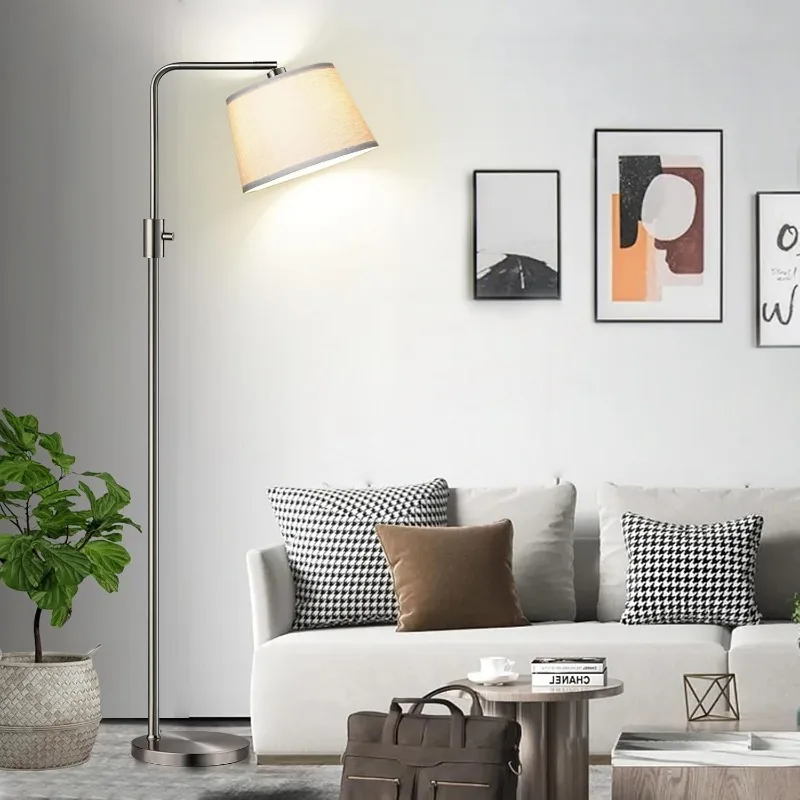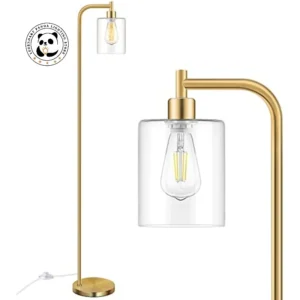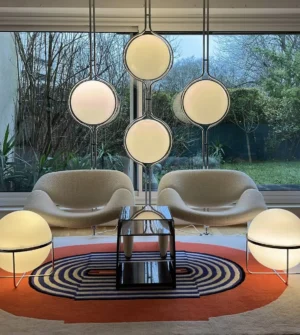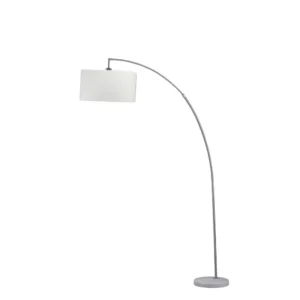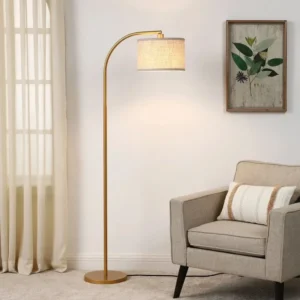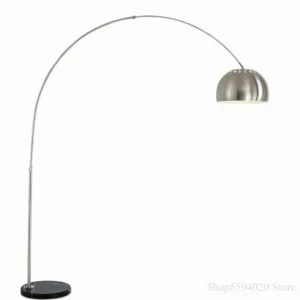Introduction: Why Finishes Matter for Arc Lamps
Arc floor lamps stand as both functional lighting solutions and striking design statements in any interior space. Their dramatic curved silhouettes create visual interest while directing light precisely where needed. When investing in these statement pieces, the finish you select plays a crucial role in determining not just how the lamp looks, but how it performs over time.
Among the most popular finishes, brass and chrome consistently emerge as top contenders, each bringing distinctive characteristics to your living space. The metal finish you choose affects how light reflects off the lamp, how it coordinates with your existing décor, and what kind of atmosphere it helps create in your room.
The right finish choice matters significantly because arc lamps aren’t just utilitarian objects—they’re long-term investment pieces that can transform a room’s ambiance. The decision between warm, golden brass and cool, silvery chrome extends beyond mere aesthetics to considerations of durability, maintenance requirements, and design versatility.
Before diving into specific comparisons, it’s worth understanding that the perfect arc floor lamp for your space requires careful consideration of all these factors. This guide will walk you through everything you need to know to make an informed decision between these two classic metal finishes.
Understanding Brass Finishes for Arc Lamps
Brass is an alloy primarily composed of copper and zinc, typically in a ratio of approximately 70% copper to 30% zinc. This composition gives brass its distinctive golden hue and unique properties that make it prized in decorative applications.
The warm undertones of brass create an inviting, luxurious appearance that brings a touch of sophistication to any room. When used in arc lamps, brass finishes interact beautifully with the light they emit, often casting a warm, ambient glow that enhances the surrounding space.
Polished Brass
Polished brass offers a bright, mirror-like surface with high reflectivity. This finish provides a formal, traditional appearance that speaks to classic elegance. The highly reflective surface maximizes light reflection, creating a luminous presence in your space. Polished brass tends to make a bold statement and works particularly well in spaces where you want the lamp to serve as a focal point.
Brushed Brass
Brushed brass features a textured surface with fine lines running in a consistent direction. This finish diffuses light rather than reflecting it directly, creating a softer, more subtle effect. The directional grain pattern reduces glare and hides fingerprints more effectively than polished surfaces. Many homeowners prefer brushed brass for its contemporary yet warm aesthetic that bridges modern and traditional design sensibilities.
Antique/Aged Brass
Antique or aged brass displays a deliberately darkened or weathered appearance that mimics the natural patina brass develops over many years. This finish offers depth and dimension through color variation, ranging from deep amber to nearly brown tones in certain areas. The rustic or vintage aesthetic of aged brass works beautifully in spaces aiming for a sense of history and character.
One of the most interesting characteristics of brass arc floor lamps is how they evolve over time. Unlike some finishes that deteriorate with age, brass often develops a natural patina that many designers and homeowners actively seek. This living finish tells a story of use and appreciation, gaining character as it ages.
Common Brass Finish Variations for Arc Lamps
Brass finishes offer remarkable versatility across different interior styles. Understanding the specific characteristics of each variation helps determine which might best suit your space:
Polished Brass:
– Features a mirror-like, highly reflective surface that maximizes light play
– Creates a formal, traditional appearance that speaks to luxury
– Tends to show fingerprints and requires more frequent cleaning
– Works beautifully in traditional, glamorous, or art deco interiors
Brushed Brass:
– Exhibits a subtle, directional grain pattern that adds visual texture
– Provides reduced reflectivity that better hides fingerprints and minor scratches
– Creates a warm, inviting appearance with significantly reduced glare
– Blends seamlessly with mid-century modern, transitional, and contemporary spaces
Antique/Aged Brass:
– Displays an artificially darkened or weathered appearance mimicking decades of use
– Offers dimension and depth through intentional color variation
– Conveys a rustic or vintage aesthetic rich in character
– Complements farmhouse, industrial, vintage, and eclectic design styles
The interaction between brass finishes and light creates distinctly different effects. Polished brass will create more dramatic light reflections, while brushed brass diffuses light for a softer glow. Antique brass tends to absorb more light, creating a more subdued presence.
For spaces that blend traditional warmth with modern elements, gold arc floor lamps in various brass tones offer excellent versatility while maintaining that warm metallic presence that brass is known for.
Understanding Chrome Finishes for Arc Lamps
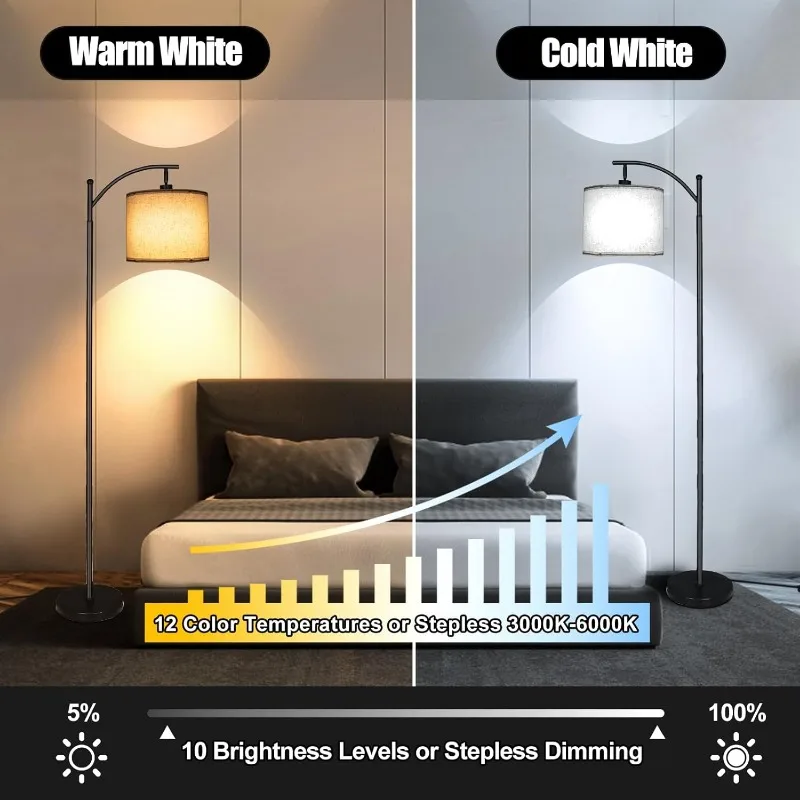
Chrome finishes are created through an electroplating process that deposits a thin layer of chromium over a base metal. This technique produces chrome’s distinctive silver-blue tone and mirror-like surface. High-quality chrome plating typically includes a layer of nickel beneath the chromium for improved adhesion and durability.
When light interacts with chrome, it creates crisp, bright reflections with cool undertones. This characteristic makes chrome arc floor lamps particularly effective in contemporary spaces where clean lines and reflective surfaces enhance the modern aesthetic.
Polished Chrome
Polished chrome provides a bright, mirror-like finish with exceptional reflectivity. This finish is prized for its brilliant shine and ability to reflect both natural and artificial light throughout a space. The high-gloss surface creates a sleek, contemporary appearance that feels fresh and clean. Polished chrome tends to make spaces feel more open and airy due to its reflective properties.
Brushed Chrome
Brushed chrome (sometimes called satin chrome) features a linear, textured surface created by fine abrasions in the metal. This process results in a softer, more diffused reflection that reduces glare while maintaining chrome’s cool tones. The subtle surface texture helps hide fingerprints and minor scratches better than polished chrome. This finish offers a more understated elegance while still providing chrome’s characteristic cool presence.
Chrome finishes typically present a decidedly modern profile, characterized by crisp edges and clean reflections. Unlike brass, which casts a golden glow, chrome enhances cool-toned light, making it an excellent choice for spaces where you want to create a sense of spaciousness and clarity.
The coolness of chrome makes it particularly effective in rooms with blue, gray, white, or black color schemes. The finish acts almost like a chameleon, picking up and reflecting surrounding colors while maintaining its distinctive silvery base tone.
Material Quality: Solid vs. Plated Finishes in Arc Lamps
Understanding the construction behind metallic finishes helps you make a more informed investment in your arc lamp:
Solid Brass Construction:
– Made from actual brass alloy throughout (not just a surface treatment)
– Significantly heavier than plated alternatives
– Naturally develops patina over time as the metal reacts with air
– Generally more expensive but offers superior longevity
– Can be refinished if damaged
Brass-Plated Finishes:
– Consists of a thin layer of brass electroplated onto a base metal (usually steel)
– Significantly lighter than solid brass
– May chip or wear through to reveal the underlying metal
– More affordable but typically shorter-lived
– Cannot be easily refinished if damaged
Chrome Plating Process:
– Always involves a plating process (chromium is applied over another metal)
– Quality chrome has multiple layers: base metal, copper, nickel, then chromium
– Premium options have thicker plating for improved durability
– Thickness of each layer significantly affects longevity
The weight of an arc lamp affects its stability and performance. Heavier bases provide better counterbalance for the arched arm, reducing the risk of tipping. This is particularly important for larger arc lamps that extend farther from their base.
To identify quality construction, look for:
– Substantial weight (especially in the base)
– Smooth, even finish without pitting or irregularities
– Proper balance when the arm is extended
– Clean welding and seamless connections
For those seeking the silver look with different properties, silver arc floor lamps offer options beyond traditional chrome, sometimes incorporating brushed nickel or other silver-toned finishes that might better suit specific interior needs.
Visual Impact: Brass vs. Chrome Arc Lamps in Interior Design
When comparing brass and chrome arc lamps, the most immediate difference lies in their visual temperature. Brass emits a warm, golden glow that brings coziness and richness to spaces. This warmth makes brass particularly effective in creating intimate, inviting environments. Chrome, conversely, presents a cool, crisp presence that feels modern and clean, often making spaces feel more expansive and airy.
Reflectivity Characteristics:
– Brass creates a soft, diffused glow that absorbs some light while reflecting warm tones
– Chrome produces bright, sharp reflections that maximize light bounce and clarity
The way each finish affects perceived space is equally important. Chrome tends to visually recede and create an impression of openness, making it excellent for smaller rooms or spaces where you want to minimize visual weight. Brass, with its stronger visual presence, creates a sense of substance and anchors a space more definitively.
These finishes interact distinctively with different color palettes:
Brass Complements:
– Earth tones (terracotta, olive, amber)
– Jewel tones (emerald, sapphire, ruby)
– Warm neutrals (cream, beige, brown)
– Rich woods and natural materials
Chrome Complements:
– Cool neutrals (gray, white, black)
– Blues and teals of all shades
– Crisp whites and high-contrast schemes
– Glass, concrete, and contemporary materials
The aesthetic differences between arc lamp finishes extend beyond just color to include how they interact with light quality throughout the day. Brass tends to maintain its warm appearance regardless of lighting conditions, while chrome can shift dramatically from bright and reflective in direct light to subdued and sophisticated in dimmer conditions.
Design Versatility: Which Decor Styles Work Best
Certain interior design styles naturally harmonize with specific finishes. Understanding these traditional pairings helps ensure your arc lamp enhances your overall aesthetic:
Brass Arc Lamps Complement:
– Traditional and classic interiors: Brass’s timeless warmth enhances traditional wood furniture and classic textiles
– Mid-century modern designs: The warm metallic tone echoes the era’s fondness for mixed materials and organic forms
– Eclectic and bohemian spaces: Brass adds a touch of vintage charm and warm sophistication to collected interiors
– Warm industrial settings: Softens industrial edges while maintaining material authenticity
– Art deco and vintage-inspired rooms: Reinforces the glamour and luxury associated with these periods
Chrome Arc Lamps Complement:
– Contemporary and minimalist interiors: Chrome’s clean reflectivity enhances sleek, uncluttered spaces
– Modern and ultra-modern designs: The crisp finish amplifies architectural lines and geometric forms
– Scandinavian aesthetics: Provides contrast to light woods and neutral textiles without overwhelming
– Cool industrial settings: Enhances factory-inspired spaces with technological precision
– Art deco and retro spaces: Emphasizes the sleek, machine-age aspects of these design movements
The versatility of both finishes has expanded in contemporary design. Modern approaches to harmonizing arc lamps with interior design often involve intentionally contrasting metals to create visual interest. For example, a chrome arc lamp can provide striking contrast in a room dominated by warm wood tones, while a brass lamp can add unexpected warmth to a predominantly cool, contemporary space.
Durability Comparison: Brass vs. Chrome Arc Lamps
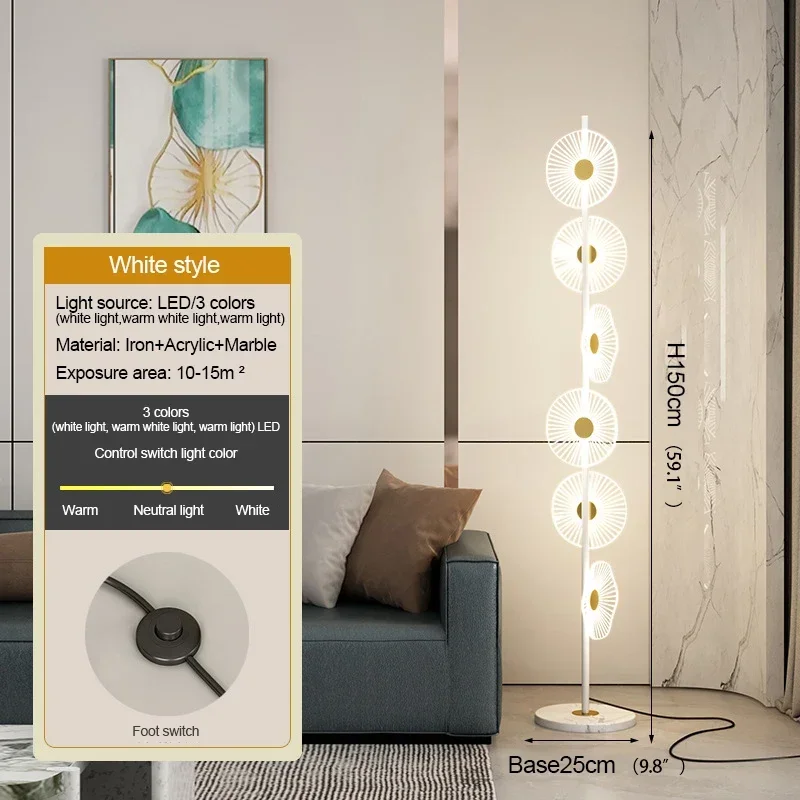
When investing in an arc lamp, understanding how each finish will hold up over time helps ensure satisfaction with your choice:
| Durability Factor | Brass | Chrome |
|---|---|---|
| Scratch Resistance | Moderate (softer metal) | High (very hard surface) |
| Tarnish Resistance | Low (naturally oxidizes) | High (resistant to oxidation) |
| Corrosion Resistance | High (especially with proper care) | Moderate (if plating is damaged) |
| Impact Resistance | High (more malleable) | Moderate (can chip if struck) |
| UV Stability | Excellent (darkens naturally) | Excellent (maintains appearance) |
Brass Durability Characteristics:
Brass naturally develops a patina over time as the copper content reacts with air and moisture. This process, called oxidation, creates a darkened surface that many appreciate as adding character and depth. However, this can be prevented through regular polishing if you prefer to maintain the original bright finish.
While brass can scratch more easily than chrome due to its softer composition, these scratches often blend into the developing patina over time. Brass is also less likely to chip than plated finishes, as it’s typically the same material throughout rather than a thin coating.
Chrome Durability Characteristics:
Chrome’s exceptional hardness makes it highly resistant to scratches and general wear. However, chrome is always a plated finish, meaning there’s a risk of chipping that could expose underlying materials. Once the chromium layer is compromised, corrosion can begin in the base metals.
Chrome excels at resisting tarnish and maintaining its bright appearance with minimal maintenance. It’s particularly well-suited to high-humidity environments like bathrooms, as it doesn’t readily oxidize like brass.
When looking for a quality arc floor lamp, pay attention to the weight and construction quality, as these often indicate the thickness of the metal and plating used.
Maintenance Requirements: Caring for Brass and Chrome Arc Lamps
Keeping your arc lamp looking its best requires different approaches depending on the finish:
Brass Maintenance:
1. Regular dusting with a soft microfiber cloth to prevent buildup that could lead to corrosion
2. For polished brass, apply a quality brass polish every 3-6 months to maintain shine
3. Use gentle, circular motions when polishing to avoid creating scratch patterns
4. Consider using a brass lacquer or sealant to protect the finish if you want to prevent patina
5. For natural patina development, simply clean with mild soap and water without polishing
Products for Brass Care:
– Dedicated brass polish (Brasso, Wright’s Brass Polish)
– Lemon juice and baking soda paste for natural cleaning
– Microfiber cloths rather than paper towels
– Avoid: abrasive cleaners, ammonia-based products
Chrome Maintenance:
1. Wipe regularly with a soft, dry cloth to remove dust and fingerprints
2. Clean with a solution of mild dish soap and water for more thorough cleaning
3. Dry completely after cleaning to prevent water spots
4. Apply automotive chrome polish occasionally for extra shine
5. Address any chips promptly to prevent underlying metal corrosion
Products for Chrome Care:
– Glass cleaner (ammonia-free)
– Chrome-specific polish for occasional deep cleaning
– Soft microfiber cloths
– Avoid: abrasive pads, acidic cleaners
The maintenance frequency for chrome is typically lower than for brass if you prefer maintaining a polished brass look. However, if you appreciate the developing patina of brass, it may require even less active maintenance than chrome, which needs regular cleaning to maintain its reflective properties.
Price Considerations: Investment Value of Brass vs. Chrome
When evaluating the investment value of brass versus chrome arc lamps, several factors influence both initial cost and long-term value:
General Price Differentials:
– Solid brass lamps typically command higher prices than chrome alternatives
– The quality of the plating process significantly affects price in both finishes
– Designer brands may charge premium prices regardless of finish
Factors Affecting Cost:
– Material composition (solid metal vs. plated)
– Thickness of plating (thicker plating costs more but lasts longer)
– Complexity of design (intricate details cost more to execute properly)
– Weight and stability features
– Additional features (dimmers, adjustability mechanisms)
From an investment perspective, both finishes offer distinct advantages. Brass tends to age gracefully, with many antique brass pieces actually increasing in value over time. The developing patina is often considered desirable, particularly in higher-end decorative items.
Chrome, while perhaps less likely to appreciate in value, offers tremendous durability and a timeless aesthetic that resists dating. Its clean lines and reflective properties ensure it remains relevant across changing design trends.
When evaluating cost versus value, consider how the perfect arc floor lamp guide emphasizes the importance of quality construction over initial price point. A well-made lamp in either finish will provide better illumination, greater stability, and longer service life than a cheaper alternative.
Current Trends and Timelessness in Arc Lamp Finishes
Both brass and chrome finishes have experienced periods of heightened popularity throughout design history, but their current status reveals interesting patterns:
Brass Trend Status:
Brass has experienced a significant resurgence in recent years, moving from being considered outdated in the early 2000s to becoming a designer favorite. Its warm tones complement the current preference for organic materials and warmer color palettes. Many designers appreciate brass for its ability to add warmth without the boldness of gold.
Chrome Trend Status:
Chrome maintains steady popularity in contemporary and minimalist designs. Its reflective properties and cool tones work particularly well with the clean lines and monochromatic palettes often found in modern interiors. Chrome has never completely fallen from favor, maintaining a consistent presence particularly in bathroom fixtures and lighting.
The cyclical nature of design trends suggests that neither finish will permanently disappear from the design landscape. Instead, they evolve in application and context. Currently, mixing metal finishes intentionally has become a sophisticated design strategy, allowing both brass and chrome to coexist within thoughtfully designed spaces.
What makes both finishes “trend-proof” is their foundation in classical design principles. Brass brings warmth and traditional elegance, while chrome offers clarity and precision. These fundamental qualities ensure that arc lamps remain in style regardless of specific trend cycles.
How To Choose: Selecting the Perfect Arc Lamp Finish
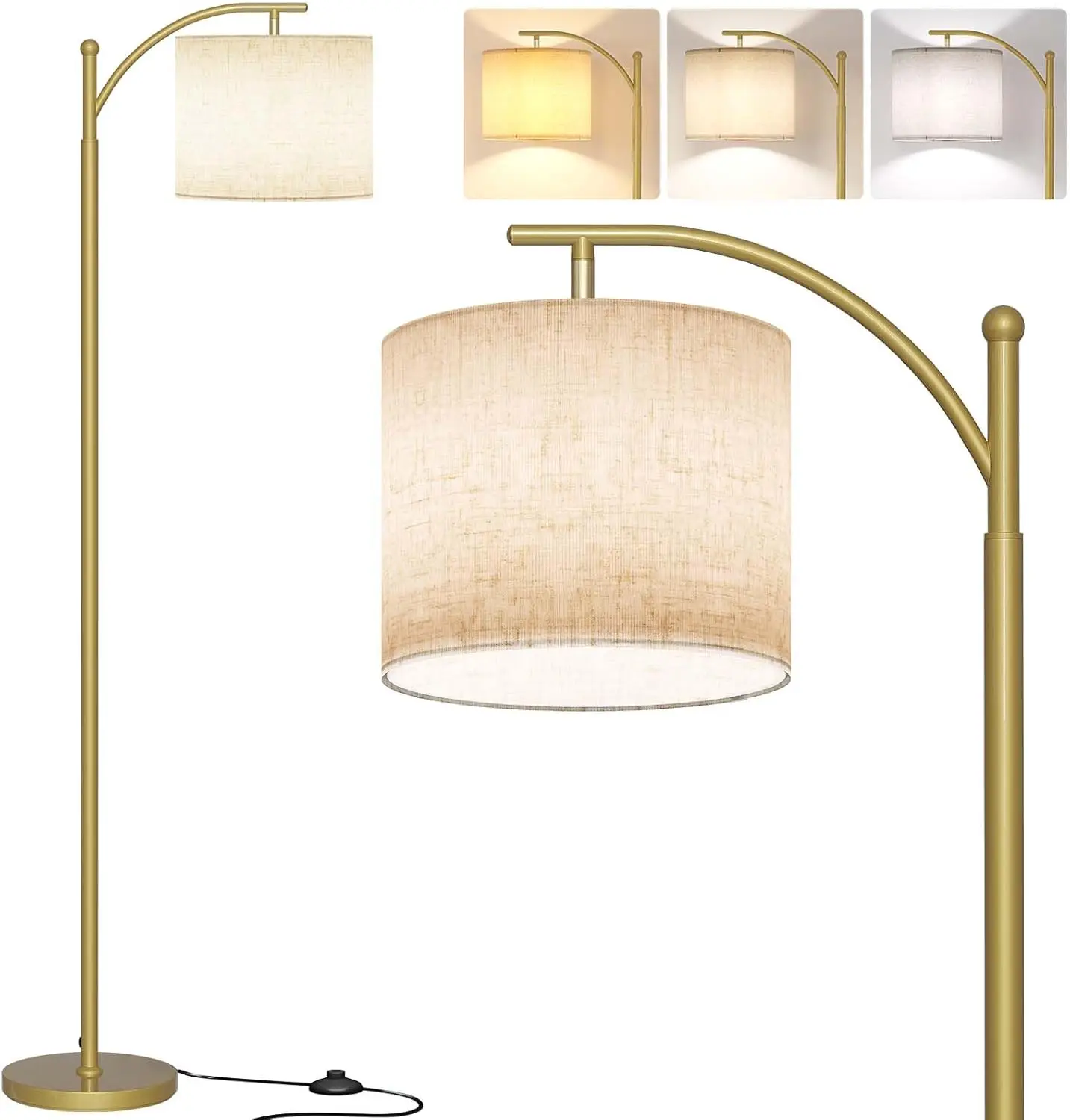
Making the final decision between brass and chrome requires evaluating several key factors in relation to your specific needs and space:
Assessment Questions to Guide Your Decision:
1. What other metal finishes exist in your space? (Consistency or intentional contrast?)
2. What is your color palette? (Warm tones favor brass; cool tones favor chrome)
3. How much maintenance are you willing to perform? (Polish brass or wipe chrome?)
4. What atmosphere are you trying to create? (Cozy and rich or clean and contemporary?)
5. How will natural light interact with the lamp throughout the day?
Choose Brass When:
– Your space features warm wood tones and natural materials
– You prefer a cozy, intimate atmosphere
– Your decor style leans traditional, vintage, or eclectic
– You appreciate how metals age and develop character over time
– You want the lamp to make a warm, substantial statement
Choose Chrome When:
– Your space features glass, stone, or cool-toned materials
– You prefer a clean, bright atmosphere
– Your decor style leans contemporary, minimal, or industrial
– You value low-maintenance finishes that maintain their look
– You want the lamp to create a sense of space and lightness
Remember that the arc lamp’s design itself makes a significant statement. The finish should complement both the lamp’s form and your space rather than competing with either. For more comprehensive guidance, the complete arc floor lamp guide offers additional factors to consider beyond just the finish.
Brass Arc Floor Lamp, Contemporary Arc Floor Lamp, LED Arc Floor Lamp
Price range: $490.72 through $522.04 Select options This product has multiple variants. The options may be chosen on the product pageChrome Arc Floor Lamp, LED Arc Floor Lamp
Price range: $304.95 through $1,210.40 Select options This product has multiple variants. The options may be chosen on the product pageContemporary Arc Floor Lamp, Silver Arc Floor Lamp
$459.99 Select options This product has multiple variants. The options may be chosen on the product pageContemporary Arc Floor Lamp, Gold Arc Floor Lamp
$196.24 Select options This product has multiple variants. The options may be chosen on the product pageChrome Arc Floor Lamp, Dimmable Arc Floor Lamp, Gold Arc Floor Lamp, LED Arc Floor Lamp
Price range: $623.49 through $2,417.47 Select options This product has multiple variants. The options may be chosen on the product pageAdjustable Arc Floor Lamp, Contemporary Arc Floor Lamp, Marble Base Arc Floor Lamp, Silver Arc Floor Lamp
Price range: $366.11 through $1,408.11 Select options This product has multiple variants. The options may be chosen on the product page
Side-by-Side Comparison: Brass vs. Chrome Arc Lamp Features
For easy reference, this comparison chart highlights the key differences between brass and chrome arc lamps:
| Feature | Brass | Chrome |
|---|---|---|
| Visual Temperature | Warm, golden | Cool, silver-blue |
| Reflectivity | Soft, diffused | Bright, crisp |
| Traditional Style Match | Excellent (5/5) | Good (3/5) |
| Contemporary Style Match | Good (4/5) | Excellent (5/5) |
| Maintenance Required | Moderate to High | Low to Moderate |
| Tarnish Resistance | Low (intentional patina) | High |
| Scratch Visibility | Low (blends with patina) | High (more noticeable) |
| Price Range | Typically Higher | Typically Lower |
| Trend Resilience | High (classic material) | High (timeless finish) |
| Visual Weight | Substantial | Light |
| Color Complementarity | Warm tones, jewel colors | Cool tones, neutrals |
| Humidity Tolerance | Moderate (needs care) | High |
This at-a-glance comparison can help clarify which characteristics matter most for your specific situation and preferences.
Frequently Asked Questions About Arc Lamp Finishes
Can I mix brass and chrome in the same room?
Yes, intentionally mixing metal finishes has become a sophisticated design strategy. The key is to make the mix look deliberate rather than accidental. Try to repeat each finish at least once elsewhere in the room for cohesion. Consider using a transitional piece that incorporates both metals to tie the look together.
Will my brass arc lamp eventually turn brown?
Brass naturally oxidizes over time, developing a darker patina that ranges from deeper gold to brown tones. This process can be prevented through regular polishing or accelerated if desired. Many high-quality brass items come with a protective lacquer coating that significantly slows this process.
How can I tell if my lamp is solid brass or just plated?
Solid brass is non-magnetic, while brass-plated steel will attract a magnet. Additionally, solid brass is heavier than plated alternatives and will have a consistent color if you look at any unfinished edges or the inside of components. Tiny chips in plated brass will reveal a different colored metal underneath.
Does chrome work in traditional homes?
While chrome is most associated with contemporary styles, it can work beautifully in traditional spaces when used thoughtfully. Consider chrome as an accent rather than a dominant element in traditional rooms. Chrome pieces with classical shapes rather than ultra-modern designs bridge the style gap more effectively.
Which finish shows dust and fingerprints more?
Polished chrome typically shows fingerprints and dust more readily than brass, especially brushed or antiqued brass. However, polished brass will also show fingerprints. If fingerprints are a major concern, consider brushed or satin finishes in either metal, as they hide marks better than highly polished surfaces.
Can I change the finish of my existing arc lamp?
While technically possible, changing a metal finish requires significant effort including stripping the existing finish, preparing the surface, and applying the new finish. Professional refinishing is often the best option if you want to change from chrome to brass or vice versa. For minor updates, consider using metallic spray paint specifically designed for metal surfaces.
Final Considerations: Making Your Arc Lamp Decision
When making your final decision between brass and chrome arc lamp finishes, remember that both options offer distinctive benefits that can enhance your space in different ways. The right choice ultimately depends on your personal aesthetic preferences, your existing décor, and the atmosphere you wish to create.
Brass brings warmth, character, and a sense of timeless elegance that works beautifully in spaces seeking coziness and depth. Chrome offers clarity, precision, and contemporary crispness that enhances modern spaces and creates a sense of openness.
Whichever finish you select, prioritize quality construction and thoughtful design. A well-made arc lamp in either finish will provide both functional lighting and aesthetic pleasure for many years to come. Trust your personal preference while considering the practical aspects we’ve discussed, and you’ll find the perfect arc lamp to illuminate your space beautifully.

